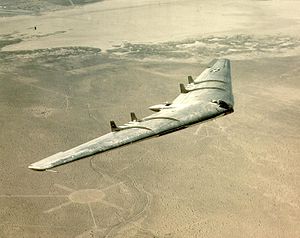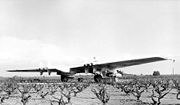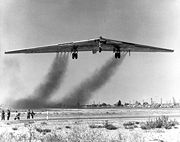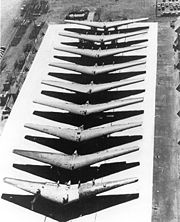Northrop YB-49 Video - N9MB - Sole survivor of the original XB-35/YB-49 long-range bomber program
More Northrop YB-49 Videos 1 2 3 4 - Northrop YB-49 Pictures
|
|
|
|
 Picture
- Northrop YB-49
Picture
- Northrop YB-49
Role - Strategic bomber
Manufacturer - Northrop Corporation
Designed by - Jack Northrop
First flight - 21 October 1947
Status - Prototype only
Primary user - United States Air Force
Number built - 3 converted from YB-35 2 YB-49 and one YRB-49A, more incomplete examples scrapped
Developed from - Northrop YB-35
The Northrop YB-49 was a prototype jet-powered flying wing medium bomber aircraft developed by Northrop for the United States Air Force shortly after World War II. It was a development of the piston-engined YB-35, and the two YB-49s actually built were both converted YB-35 test aircraft. The aircraft was never to enter production, however, being passed over in favor of the more conventional Boeing B-47 in service.
 Picture
- Northrop YRB-49A with six engines, two of which are mounted externally.
Picture
- Northrop YRB-49A with six engines, two of which are mounted externally.
Design and development
With the B-35 program seriously behind schedule by 1944, and the end of the piston-engined combat aircraft in sight, the production contract for the type was cancelled in May. Nevertheless, the design was still sufficiently interesting to the Air Force that work on the pre-production aircraft was ordered to continue for testing purposes. Among the aircraft to be completed were two that the Air Force required to be fitted with jet propulsion.
 Picture
- YB-49 during takeoff
Picture
- YB-49 during takeoff
The first aircraft flew on 21 October 1947 and immediately proved more promising than its piston-engined counterpart. The YB-49 set both an unofficial endurance record of staying continually above 40,000 ft (12,200 m) for six hours, and a trans-continental speed record, flying from Muroc Air Force Base in California to Andrews Air Force Base near Washington, D.C. in 4 hours 20 minutes. The return flight from Andrews was marred by a multiple failure in six of the eight engines. Inspection after a successful emergency landing revealed no oil had been replaced in these engines after the Muroc to Andrews leg raising suspicion of sabotage. The Air Force engineer in charge of this detail became ill shortly before the scheduled departure and did not accompany the YB-49 back to Muroc. He later died in a motorcycle accident under mysterious circumstances. The Northrop corporation was always a technological trailblazer but the independent nature of Jack Northrop often collided with political wheeling and dealing that tended to run huge military allocations.
 Picture
- Nearly complete YB-49s lined up for destruction
Picture
- Nearly complete YB-49s lined up for destruction
The second YB-49 was lost on 5 June 1948, killing its pilot, Major Daniel Forbes for whom Forbes Air Force Base was named, Captain Glen Edwards, copilot (after whom Edwards Air Force Base is named), and three other crew members, one of whom, Lt. Edward Lee Swindell was a crewmember on the B-29 that assisted Chuck Yeager to break the sound barrier. The aircraft suffered structural failure, with both outer wing sections becoming detached from the center section. Speculation at the time was that the aircraft was lost due to excessive pullout loads imposed when a stall recovery resulted in a high speed dive. The post stall high speed dive resulted from the Northrop flying wings clean, low drag design which gave a rapid speed increase in any type of dive. The last operational YB-49 prototype was destroyed during high speed taxi trials at Muroc. The nosewheel began to encounter severe vibration problems and collapsed. The aircraft was completely destroyed in the ensuing fire. The taxi trials took place with fuel tanks full, an unusual testing procedure further fanning speculation of sabotage.
The Air Force ordered the remaining uncompleted YB-35 aircraft completed as B-35Bs, which were essentially identical to the YRB-49A mentioned below.
Bombing tests showed that the tendency of flying wings to "hunt" in yaw after turns and when in "disturbed" air degraded bombing accuracy unless an autopilot or yaw damper was used.
Operational history
In September 1948, the Air Force ordered the type into production as the RB-49A reconnaissance aircraft, which was powered by six engines, two externally mounted in pods. This contract was cancelled two months later at the direction of Air Force Secretary Stuart Symington. In a 1979 taped interview, Jack Northrop claimed the flying wing contract was cancelled because Northrop Aircraft Corporation would not agree to a merger with competitor Convair as Stuart Symington wanted, because according to Jack Northrop, Convair's merger demands were "grossly unfair to Northrop."
Cancellation of the YRB-49 contract freed up money for the preferred Air Force strategic bomber, the Convair B-36 Peacemaker and the importance that the USAF placed on this program effectively doomed the Northrop flying wings.
During early 1950 the remaining YB-35B jet conversions of the B-35 aircraft were scrapped.
Flight testing of the remaining YB-49 prototype ended 14 March 1950. On 15 March 1950, the program was cancelled completely, and coincidentally, the prototype suffered a high speed taxiing accident and was totally destroyed in the ensuing fire.
The prototype reconnaissance platform, the YRB-49A first flew on 4 May 1950, and testing ended 26 April 1951. The YRB-49A was scrapped 1 December 1953.[1] The YB-49 and its modern counterpart, the B-2, both built by Northrop, have the same wingspan: 172.0 ft (52.4 m).
Popular culture
Stock footage of a YB-49 in flight appeared in The War of the Worlds (1953). In the movie, the Flying Wing was tasked with dropping an atomic bomb on the invading Martians.
Specifications (YB-49)
Data from Air Force Fact Sheet
General characteristics
Crew: 7
Length: 53 ft 1 in (16.0 m)
Wingspan: 172 ft 0 in (52.4 m)
Height: 20 ft 3 in (6.2 m)
Wing area: 4,000 ft² (371.6 m²)
Airfoil: NACA 65-019 root, NACA 65-018 tip
Empty weight: 88,442 lb (40,116 kg)
Loaded weight: 133,559 lb (60,581 kg)
Max takeoff weight: 193,938 lb (87,969 kg)
Powerplant: 8 (6 J35-A-19 on the YRB-49A)× Allison/General Electric J35-A-5 turbojets, 4,000 (5,000 for J35-A-19) lbf (17 kN) each
Performance
Maximum speed: 495 mph (793 km/h)
Range: 9,978 mi (16,057 km) Maximum[2]
Combat radius: 1,615 mi (2,599 km)
Service ceiling: 45,700 ft (13,900 m)
Rate of climb: 3,758 ft/min (19.1 m/s)
Wing loading: 33 lb/ft² (163 kg/m²)
Thrust/weight: 0.23
Armament
Guns: 4 × .50 in (12.7 mm) machine guns
Bombs: 32,000 lb (14,500 kg)
Related development
Northrop N1M
Northrop N9M
Northrop YB-35
B-2 Spirit
Comparable aircraft
Horten Ho 229
References
Notes
1. Northrop YRB-49A
2. Winchester 2005, p. 193.
Bibliography
Coleman, Ted. Jack Northrop and the Flying Wing: The Real Story Behind the Stealth Bomber. New York: Paragon House, 1988. ISBN 1-55778-079-X.
Donald, David, ed. "Northrop Flying Wings." Encyclopedia of World Aircraft. Etobicoke, Ontario: Prospero Books, 1997. ISBN 1-85605-375-X.
Maloney, Edward T. Northrop Flying Wings. Corona del Mar, California: World War II Publications, 1988. ISBN 0-915464-00-4.
Pape, Garry and John Campbell. Northrop Flying Wings: A History of Jack Northrop's Visionary Aircraft. Atglen, PA: Schiffer Publishing, Ltd., 1995. ISBN
0-88740-689-0.
Winchester, Jim. "Northrop XB-35/YB-49." Concept Aircraft: Prototypes, X-Planes and Experimental Aircraft. Kent, UK: Grange Books plc., 2005.
ISBN 1-84013-309-2.
Living Warbirds: The best warbirds DVD series.
Source: WikiPedia